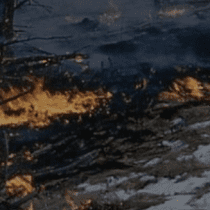Fire History
Webinar recording.
Conflagrations like the 1871 Peshtigo have reemerged as important threats across North America and around the world. Understanding the factors and the phenomena that produced the fire environment of that day is possible because of weather observations collected and recorded at the time and studies of extreme fire behavior that continue to this day. Recounting it should be a cautionary tale for our lives as we continue to live them.
View article.
Our data revealed that ventenata frequency and cover increased on all plots. However, there was not significantly higher abundance in burned plots in any of the sampling years. In addition, ventenata abundance did not increase more in burned plots over time. Our findings suggest that, unlike cheatgrass, fire may not be a driving factor in the spread and increase of ventenata across the PNB Prairie. This finding has important implications for the management and control of ventenata, as well as the conservation of the PNB Prairie.
Webinar recording.
Dendrochronology: The trees that surround us have a story to tell, yet so many of us have no idea what that story is. What is dendrochronology? How old is the oldest recorded tree? Can trees get scars? Where are some of the oldest forests located? These are just some of the questions we aim to answer with our guest Dr. Justin DeRose, Assistant Professor of Silviculture and Applied Forest Ecology at Utah State University.
We’ve spent 100 years growing a tinderbox across the West. Now it’s wildfire season. Controlled burning – an indigenous tradition that’s been used for millennia – might be a solution.
Fire researchers discuss the return of fire to western U.S. landscapes in the context of wildfire history.
In the Western U.S., the 2020 fire season is setting new records in terms of geographic scale, fire intensity, and rates of spread. Tens of millions of people are currently being forced to breathe beneath a dense layer of smoke, as others have lost their lives and property.
With each new record-setting fire, the same question comes up again and again: is this due to climate change, or is this due to forest mismanagement? After dueling appearances on Monday, this question now appears to be a matter of debate in the Presidential campaign.
The climate change vs. management question ignores nuance that is crucial for finding scientific answers and policy solutions. The factors influencing wildfire behavior are complex, and the dominant drivers vary between different locations and events. Below are five key things to know about the causes of the current wildfire problem. Understanding them can help us navigate the question of what is driving increased fire activity and what can be done to reduce such large fires in the future.
Disturbance refugia – locations that experience less severe or frequent disturbances than the surrounding landscape – provide a framework to highlight not only where and why these biological legacies persist as adjacent areas change but also the value of those legacies in sustaining biodiversity. Recent studies of disturbance refugia in forest ecosystems have focused primarily on fire, with a growing recognition of important applications to land management. Given the wide range of disturbance processes in forests, developing a broader understanding of disturbance refugia is important for scientists and land managers, particularly in the con-text of anthropogenic climate change. We illustrate the framework of disturbance refugia through the individual and interactive effects of three prominent forest disturbance agents: fire, drought, and insect outbreaks. We provide examples of disturbance ref-ugia and related applications to natural resource management in western North America, demonstrate methods for characterizing refugia, identify research priorities, and discuss why a more comprehensive definition of disturbance refugia is relevant to conser-vation globally
Webinar recording.
Description: Range of Variability (ROV) concepts – including Natural (NRV), Historic (HRV), Current (CRV), and Future (FRV) – are frequently used by the US Forest Service to help define land management goals. This webinar provides an introduction to ROV terminology and examples of how the Malheur, Umatilla, and Wallowa-Whitman National Forests in the Blue Mountains have applied ROV concepts during project planning when addressing key requirements of the Eastside Screens. The discussion includes overviews of tools commonly used to conduct ROV analyses.
Presenter: Nathan Poage, Forest Service Ecologist,
View article.
The structure and composition of sagebrush‐dominated ecosystems have been altered by changes in fire regimes, land use, invasive species, and climate change. This often decreases resilience to disturbance and degrades critical habitat for species of conservation concern. Basin big sagebrush (Artemisia tridentata ssp. tridentata) ecosystems, in particular, are greatly reduced in distribution as land has been converted to agriculture and other land uses. The fire regime, relative proportions of shrub and grassland patches, and the effects of repeated burns in this ecosystem are poorly understood. We quantified postfire patterns of vegetation accumulation and modeled potential fire behavior on sites that were burned and first measured in the late 1980s at John Day Fossil Beds National Monument, Oregon, USA. The area partially reburned 11 yr after the initial fire, allowing a comparison of one vs. two fires. Repeated burns shifted composition from shrub‐dominated to prolonged native herbaceous dominance. Fifteen years following one fire, the native‐dominated herbaceous component was 44% and live shrubs were 39% of total aboveground biomass. Aboveground biomass of twice‐burned sites (2xB; burned 26 and 15 yr prior) was 71% herbaceous and 12% shrub. Twenty‐six years after fire, total aboveground biomass was 113–209% of preburn levels, suggesting a fire‐return interval of 15–25 yr. Frequency and density of Pseudoroegneria spicata and Festuca idahoensis were not modified by fire history, but Poa secunda was reduced by repeated fire, occurring in 84% of plots burned 26 yr prior, 72% of plots burned 15 yr prior, and 49% in 2xB plots. Nonnative annual Bromus tectorum occurred at a frequency of 74%, but at low density with no differences due to fire history. Altered vegetation structure modified fire behavior, with modeled rates of fire spread in 2xB sites double that of once‐burned sites. This suggests that these systems likely were historically composed of a mosaic of shrub and grassland. However, contemporary increases in fire frequency will likely create positive feedbacks of more intense fire behavior and prolonged periods of early‐successional vegetation in basin big sagebrush communities.
View paper.
Historically, the ecotone was a matrix of prairie with extensive savanna and some forest. More than half of the ecotone area was prairie, which is now dominated by agriculture, with some residential development. The 16% of the landscape that was pine savanna is now forest or shrubs, agriculture, perennial vegetation under the Conservation Reserve Program, or developed; no savanna now exists. Forests covered 12% of the ecotone and these are still mostly forest. Fires were historically frequent, occurring on average every 5 to 8 years at most sites. Lightning was not frequent but could likely have been sufficient to ignite fires that could spread readily given the rolling terrain and long fire season. Fire was far more frequent historically than currently. Conservation, restoration, and other ongoing land-use changes will likely result in more continuous vegetation and hence fuel for fires. Lightning and people may ignite fires that therefore spread readily in the future. Understanding the past and potential future of fire in the Palouse Prairie bioregion may help us live with fire while conserving ecological values here and in similar prairie–forest ecotones.




